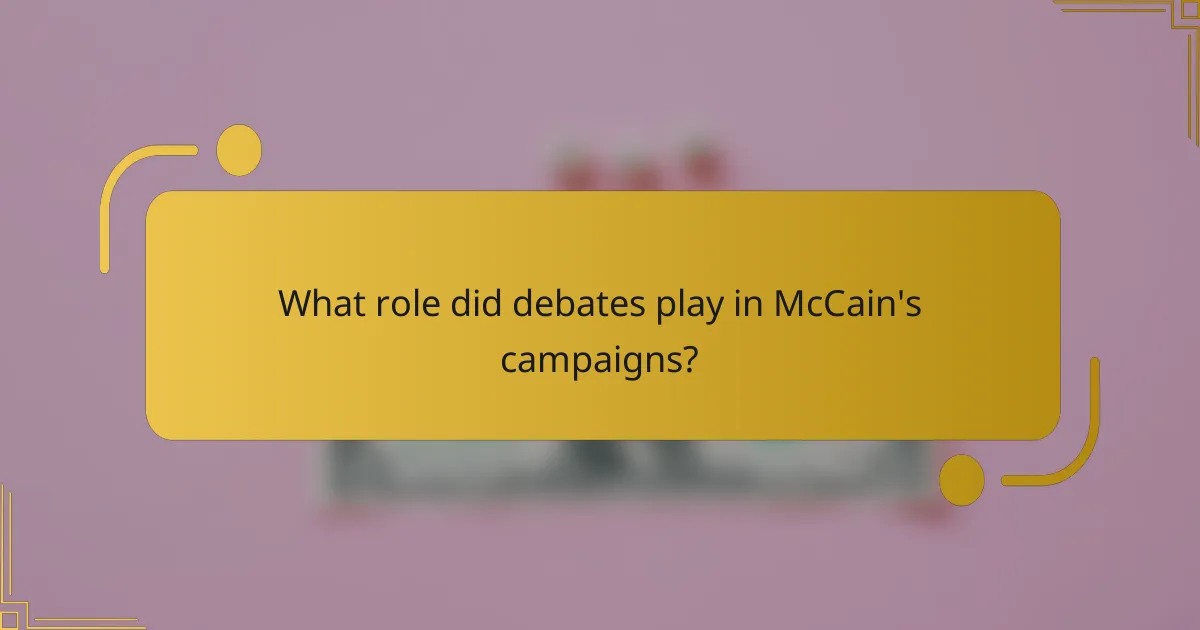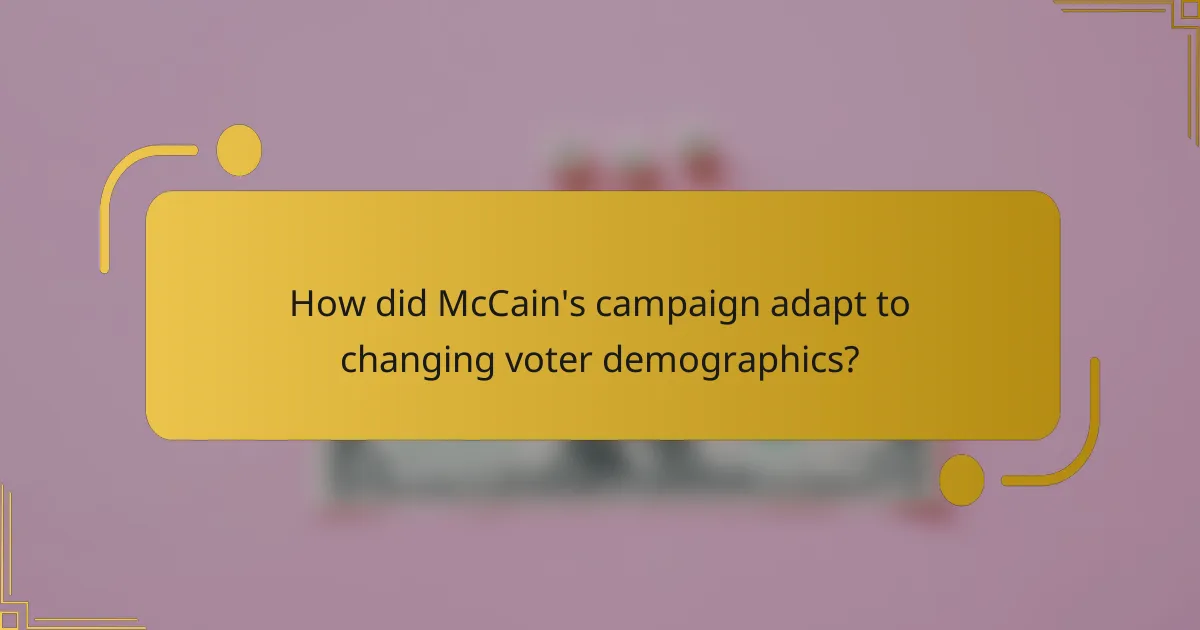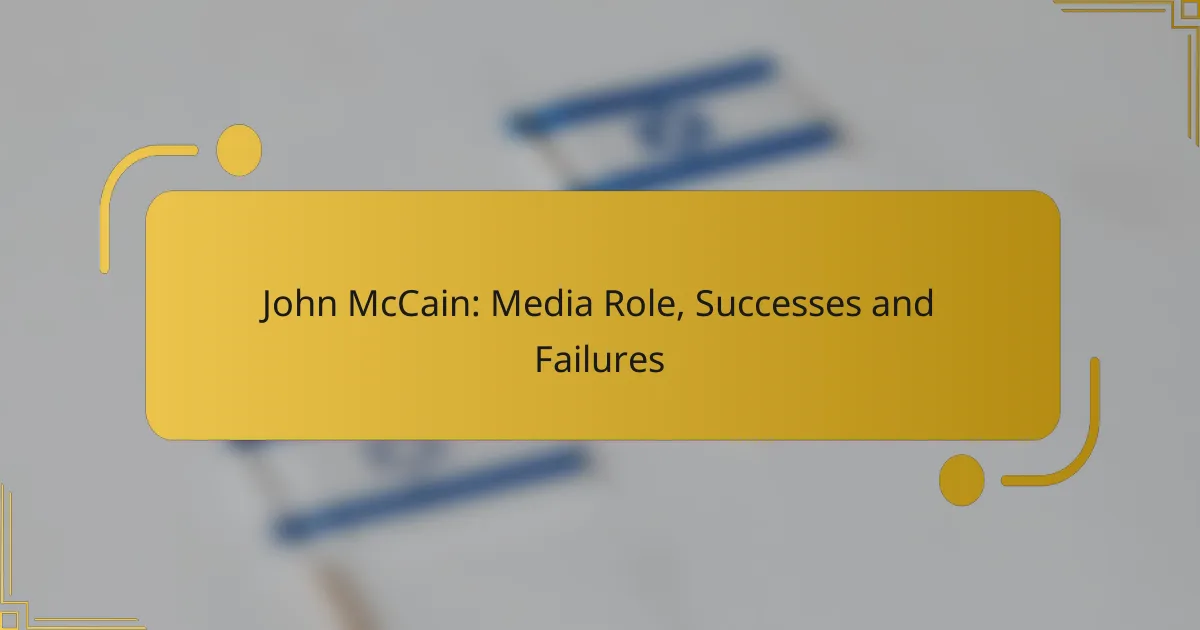John McCain’s presidential campaigns were marked by a strong focus on personal narrative and military service, utilizing town hall meetings to foster connections with voters. While these tactics were effective in their time, they contrast sharply with modern strategies that prioritize digital engagement and data analytics. Nonetheless, McCain’s emphasis on authenticity and grassroots mobilization offers valuable lessons for contemporary campaigns seeking to connect meaningfully with their constituents.

What campaign tactics did John McCain use in his presidential runs?
John McCain’s presidential campaigns were characterized by a focus on personal narrative, an emphasis on military service, and the utilization of town hall meetings. These tactics helped him connect with voters and differentiate himself from his opponents.
Focus on personal narrative
McCain’s personal story was a cornerstone of his campaign strategy. He often shared his experiences as a prisoner of war, which resonated deeply with many voters and showcased his resilience and patriotism.
This narrative not only humanized him but also positioned him as a candidate with a unique perspective on sacrifice and service. By weaving personal anecdotes into his speeches, he created an emotional connection that appealed to a wide audience.
Emphasis on military service
Military service played a significant role in McCain’s identity and campaign messaging. He highlighted his background as a naval aviator and his time as a POW, which underscored his commitment to the country and national security.
This emphasis on military experience helped him gain credibility among voters who valued defense issues. It also allowed him to contrast himself with opponents who lacked similar backgrounds, reinforcing his image as a strong leader in times of conflict.
Utilization of town hall meetings
McCain frequently engaged with voters through town hall meetings, which allowed for direct interaction and feedback. These informal settings enabled him to address concerns and answer questions, fostering a sense of accessibility and transparency.
This tactic was particularly effective in smaller communities, where personal connections are vital. By prioritizing face-to-face communication, McCain could build trust and demonstrate his commitment to listening to constituents’ needs.

How do McCain’s tactics compare to modern campaign strategies?
John McCain’s campaign tactics, while effective in their time, differ significantly from modern strategies that leverage technology and data. Today’s campaigns prioritize digital engagement and data analytics to connect with voters more efficiently.
Increased use of social media
Modern campaigns utilize social media platforms extensively to engage with voters in real-time. Unlike McCain’s era, where traditional media dominated, candidates now use platforms like Twitter, Facebook, and Instagram to share messages, respond to criticism, and mobilize supporters.
For instance, social media allows campaigns to target specific demographics with tailored messages, which can lead to higher engagement rates. This shift has made it essential for candidates to maintain a consistent online presence and interact directly with constituents.
Data-driven voter targeting
Today’s campaigns rely heavily on data analytics to identify and target potential voters. This approach contrasts with McCain’s reliance on broader outreach methods, as modern strategies involve analyzing voter behavior and preferences to create personalized communication.
Campaigns now use data to segment voters into groups based on various factors, such as age, location, and interests. This targeted approach can significantly increase the effectiveness of campaign messages and improve voter turnout.
Focus on digital advertising
Digital advertising has become a cornerstone of modern campaign strategies, shifting away from the television and print ads that characterized McCain’s campaigns. Online ads can be more cost-effective and offer precise targeting options, allowing campaigns to reach specific audiences with tailored messages.
For example, platforms like Google and Facebook enable campaigns to run ads that appear only to users who fit certain criteria, maximizing the return on investment. This focus on digital advertising means that campaigns must continuously adapt their strategies based on real-time performance metrics to optimize their outreach efforts.

What lessons can modern campaigns learn from McCain’s approach?
Modern campaigns can learn the importance of authenticity and grassroots engagement from John McCain’s approach. His strategies emphasized genuine connections with voters and mobilizing support at the community level, which remain effective in today’s political landscape.
Importance of authenticity
Authenticity in a campaign fosters trust and relatability. McCain’s straightforward communication style and personal storytelling resonated with voters, making him appear genuine and approachable. Modern campaigns should prioritize transparency and honesty to build similar connections.
To enhance authenticity, candidates can share personal experiences and values that align with their audience’s concerns. Engaging in unscripted moments during public appearances can also reinforce a candidate’s genuine persona, making them more relatable to voters.
Engagement through grassroots efforts
Grassroots efforts are vital for mobilizing support and creating a strong voter base. McCain effectively utilized local volunteers and community events to connect with constituents, demonstrating the power of grassroots organizing. Modern campaigns should leverage these tactics to foster deeper community ties.
Campaigns can implement strategies such as door-to-door canvassing, town hall meetings, and local partnerships to engage voters directly. Utilizing social media platforms for grassroots organizing can also amplify outreach efforts, allowing campaigns to connect with a broader audience while maintaining a personal touch.

What role did debates play in McCain’s campaigns?
Debates were a crucial component of John McCain’s campaigns, serving as platforms to communicate his policies and connect with voters. They provided opportunities to contrast his positions with those of his opponents, shaping public perception and influencing voter decisions.
Highlighting policy differences
McCain effectively used debates to emphasize his policy differences, particularly on key issues like healthcare, foreign policy, and the economy. By clearly articulating his stance on these topics, he aimed to appeal to undecided voters and reinforce his base’s support.
For instance, during the 2008 presidential debates, McCain focused on contrasting his approach to the Iraq War with that of his opponent, showcasing his experience and commitment to national security. This tactic aimed to resonate with voters concerned about military and foreign affairs.
Showcasing personal character
In addition to policy discussions, McCain’s debates highlighted his personal character, portraying him as a principled leader with a strong moral compass. His reputation for bipartisanship and integrity was often emphasized, appealing to voters looking for authenticity.
McCain’s personal anecdotes and stories of service were strategically woven into his debate performances, helping to humanize him and create an emotional connection with the audience. This approach aimed to differentiate him from opponents perceived as more politically calculated.

How did McCain’s campaign adapt to changing voter demographics?
McCain’s campaign effectively adjusted its strategies to address evolving voter demographics, particularly by focusing on suburban voters and Hispanic communities. These adaptations were crucial in appealing to diverse groups and enhancing voter engagement.
Targeting suburban voters
McCain’s campaign recognized the importance of suburban voters, who often play a pivotal role in elections. By tailoring messages that resonated with their concerns, such as economic stability and local issues, the campaign aimed to secure their support.
Strategies included hosting town hall meetings and utilizing local media to connect with suburban audiences. This grassroots approach helped to build trust and foster a sense of community involvement, which was essential for gaining traction in these areas.
Outreach to Hispanic communities
To engage Hispanic voters, McCain’s campaign implemented targeted outreach efforts that acknowledged the unique challenges faced by these communities. This included emphasizing immigration reform and economic opportunities, which were key issues for many Hispanic voters.
The campaign also collaborated with local organizations and leaders to enhance credibility and reach. By participating in cultural events and utilizing bilingual materials, McCain aimed to create a more inclusive campaign that resonated with Hispanic constituents.

What are the key differences in fundraising strategies?
John McCain’s fundraising strategies differed significantly from modern tactics, particularly in their reliance on traditional methods versus innovative approaches. While McCain utilized established fundraising channels, contemporary campaigns increasingly leverage digital platforms and grassroots movements to maximize contributions.
Grassroots fundraising vs. PAC contributions
Grassroots fundraising focuses on small donations from a large number of individuals, often mobilizing supporters through community engagement and events. This approach fosters a sense of ownership among donors and can create a strong volunteer base. In contrast, PAC contributions typically come from Political Action Committees, which aggregate funds from a limited number of larger donors, often leading to significant financial backing but less personal engagement.
Modern campaigns often prioritize grassroots fundraising to build a broad support network, while PAC contributions can provide immediate financial resources. Balancing both strategies can be effective, but campaigns should be cautious of over-reliance on PACs, as this may alienate smaller donors.
Online fundraising techniques
Online fundraising techniques have transformed campaign financing by enabling candidates to reach a wider audience quickly and efficiently. Methods such as crowdfunding platforms, social media campaigns, and email solicitations allow for real-time engagement and can generate substantial contributions in short periods. For instance, campaigns can use targeted ads on platforms like Facebook or Instagram to appeal to specific demographics.
Successful online fundraising requires compelling messaging and a user-friendly donation process. Campaigns should also consider employing A/B testing to optimize their outreach strategies. However, they must remain compliant with regulations regarding online donations, ensuring transparency and proper reporting of contributions.

How did media coverage influence McCain’s campaigns?
Media coverage played a crucial role in shaping John McCain’s campaigns, influencing public perception and voter engagement. His relationship with the press often dictated the narrative surrounding his candidacy, impacting both his strengths and vulnerabilities.
Impact of press relations
McCain’s press relations were characterized by a mix of accessibility and strategic engagement. He often utilized media appearances to convey his message directly to voters, fostering a sense of authenticity. This approach helped him connect with the public, especially during his 2000 campaign, where he gained significant traction through town hall meetings and candid interviews.
However, McCain’s openness sometimes backfired, as it allowed the media to scrutinize his statements and actions closely. The press’s focus on his personal story and military background often overshadowed policy discussions, which could skew voter perceptions.
Response to negative press
McCain’s response to negative press was multifaceted, often involving direct rebuttals and strategic messaging. He frequently addressed criticisms head-on, using press conferences and interviews to clarify his positions and counter misinformation. This proactive approach helped mitigate some damage from unfavorable coverage.
Despite his efforts, McCain faced challenges in overcoming negative narratives, particularly during the 2008 election. The media’s focus on his age and the selection of Sarah Palin as his running mate created a narrative that was difficult to shift. Understanding how to navigate negative press is crucial for any candidate, as it can significantly impact voter sentiment and campaign momentum.

What emerging trends in campaign tactics can be observed today?
Modern campaign tactics have evolved significantly, focusing on digital engagement, data analytics, and personalized messaging. These trends enhance voter outreach and influence, making campaigns more targeted and efficient.
Increased use of social media platforms
Social media has become a cornerstone of modern campaign strategies, allowing candidates to connect directly with voters. Platforms like Facebook, Twitter, and Instagram enable real-time communication and the sharing of campaign messages, often tailored to specific demographics.
Campaigns can utilize targeted ads based on user data, ensuring that messages reach the intended audience. This approach can lead to higher engagement rates compared to traditional media, where messages are broadcast to a broader audience without customization.
Data-driven decision making
Data analytics plays a crucial role in shaping campaign strategies today. Campaign teams analyze voter behavior, preferences, and demographics to refine their messaging and outreach efforts. This data-driven approach allows for more effective allocation of resources and targeted messaging.
By leveraging tools like voter databases and analytics software, campaigns can identify key voter segments and tailor their strategies accordingly. This results in more efficient use of campaign budgets and potentially higher voter turnout.
Emphasis on grassroots mobilization
Grassroots mobilization remains a vital tactic, but it has adapted to include digital tools. Modern campaigns encourage supporters to engage online, share content, and organize events through social media, amplifying their reach and impact.
Campaigns often harness the power of local volunteers to create a sense of community and ownership among voters. This approach not only fosters loyalty but also encourages more personal interactions, which can be more persuasive than traditional advertising methods.



